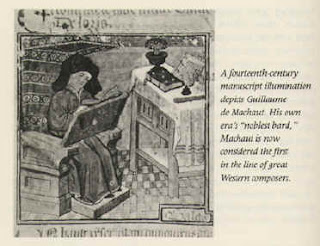
Lindsay Lozito
351 WI
Dr. Granade
September 15, 2009
Guillaume De Machaut: Messe de Nostre Dame
Guillaume de Machaut, one of the leading composers of the fourteenth century, composed his greatest and most unique pieces, Messe De Nostre Dame in the early 1360s. The Messe De Nostre Dame, meaning Mass of Our Lady, contains six items from the Mass Ordinary - the Kyrie, Gloria, Credo, Sanctus, Agnus Dei, and Ite Missa Est - and was one of the first polyphonic masses written as a single unit. Before Machaut wrote the work in the fourteenth century, chants from the Mass Ordinary usually were not set polyphonically; polyphonic writing was reserved for the Proper. Machaut, however, built his mass on the text of the Mass Ordinary and treated the six movements as one, linking the movements together by similar styles, reoccurring motives, and keeping a t onal focus. The combined movements in Machaut’s mass are longer than any other mass in the fourteenth century.
onal focus. The combined movements in Machaut’s mass are longer than any other mass in the fourteenth century.
Messe De Nostre Dame was composed for four voices consisting of a duplum and triplum written above the tenor voice and a contratenor, which is most often in the same range as the tenor. Occasionally the contratenor will be written above or below the tenor line. According to the manuscript of the piece, it is assumed that soloists would have been the singers for the Messe De Nostre Dame. There is some controversy of whether or not instruments were a part of Machaut’s original composition of the Messe de Nostre Dame. Evidence proves that only unaccompanied voices appear in the original composition, although during the fourteenth century instruments were often used during Mass and special occasions.
The Messe de Nostre Dame presents three wide-ranging styles throughout the piece. The three styles consist of a motet style, related to the isorhythmic motet Machaut wrote; a discant style, where the lower voices support the moving upper voices; and simultaneous style, in which all voices move in near or strict homophony. Examples of the simultaneous style and the discant style can be found in the Gloria and the Credo of the Messe De Nostre Dame. You can see how the rhythms are almost identical in all four voices. Occasionally you will see the bottom voices sustaining notes, while the top voice sings a more decorative part. The motet style makes up the Kyrie, Sanctus, Agnus Dei and Ite Missa Est of the mass. When listening to the record of the Messe De Nostre Dame, you can also hear examples of florid organum, where the lower voices support the “florid” upper voices. With the discant style all the voices move at the same pace with only a couple of notes for each note of the lower voices. The florid organum is similar to the discant style; only there are multiple notes in the upper voices for every one note of the lower voices. With florid organ um, the words and the direction of the piece seem to lose their meaning, but the way Machaut composed the intricate rhythms and wide-ranging harmonies helps draw the listener in making the piece more appealing.
um, the words and the direction of the piece seem to lose their meaning, but the way Machaut composed the intricate rhythms and wide-ranging harmonies helps draw the listener in making the piece more appealing.
While listening to the Messe de Nostre Dame, you can hear examples of both discant and florid organum. Normally I tend to lose interest with the florid organum style because the meaning of the word is lost and sometimes the direction of the piece. With Messe de Nostre Dame, I was surprised to find myself intrigued by the work. Though the piece contains a majority of the florid organum style, Machaut made the piece more fascinating by use of rhythmic variations and the assorted harmonies within the four voices. The sections that grabbed my attention overall were the syncopation rhythms found throughout the piece. When those syncopation sections arose in the music, I felt the presence of another culture or style change. Thinking about medieval music, long melismic chants come to mind, but the Messe de Nostre Dame changed my perception. I used to assume that all medieval music was unexciting and monotonous, but this piece has changed my opinion. Messe de Nostre Dame has helped expand my knowledge of the depths of medieval music.

 onal focus. The combined movements in Machaut’s mass are longer than any other mass in the fourteenth century.
onal focus. The combined movements in Machaut’s mass are longer than any other mass in the fourteenth century. um, the words and the direction of the piece seem to lose their meaning, but the way Machaut composed the intricate rhythms and wide-ranging harmonies helps draw the listener in making the piece more appealing.
um, the words and the direction of the piece seem to lose their meaning, but the way Machaut composed the intricate rhythms and wide-ranging harmonies helps draw the listener in making the piece more appealing.
excellent!
ReplyDelete